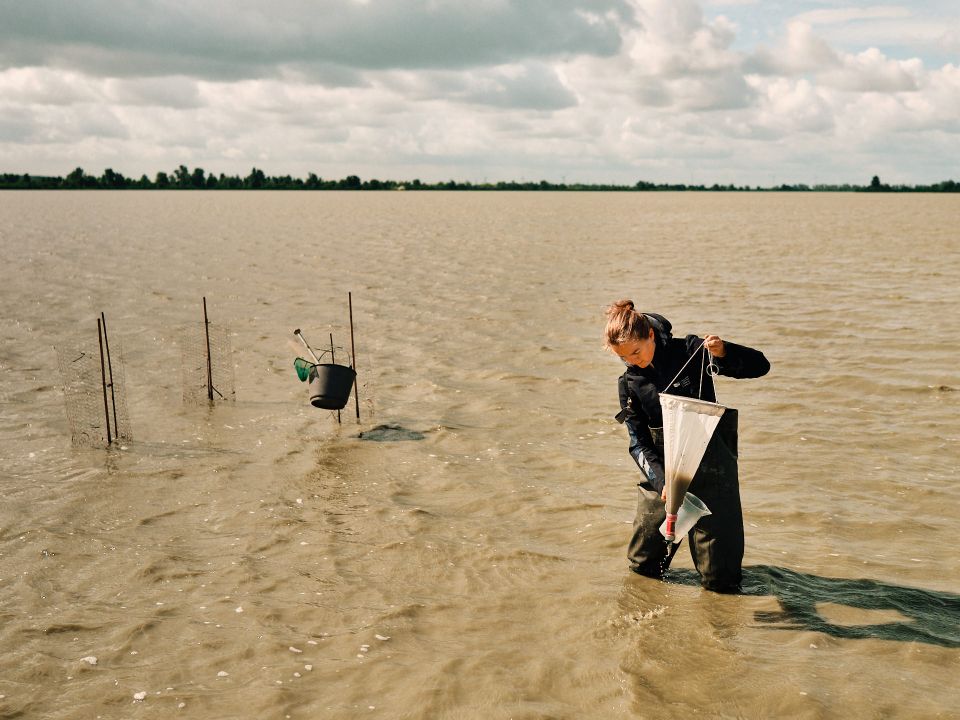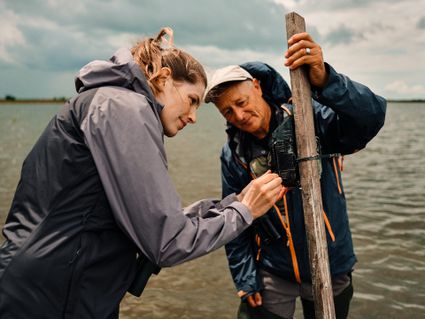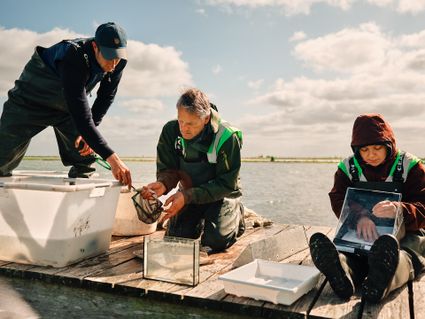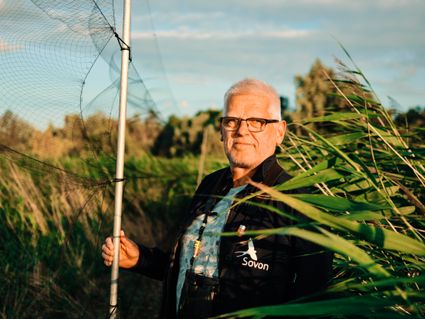Who eats whom in the marsh land of the Oostvaardersplassen? - Kerstin examines the effects of reclamation on the food web
What do fat carp have to do with short-legged birds? And how high can reeds grow if red deer have no chance to gnaw at them? Kerstin Bouma's PhD research requires plodding work: lugging equipment through cold, wet conditions and wild reed beds. But, it answers a lot of interesting questions about Oostvaardersplassen, part of National Park Nieuw Land.
Kerstin works at the NIOO-KNAW (Netherlands Institute of Ecology) and next year will receive her PhD from WUR (Wageningen University & Research). Her research focuses on the "food web" in the Oostvaardersplassen. By food web in ecology is meant a who-eats-who in an ecosystem. Kerstin zooms in on the role of big fish and red deer in the system. 'My motivation to do this research comes from my passion for science and my love for wild and untouched areas, such as the Oostvaardersplassen. It's a unique and rugged part of the Netherlands, where I love doing research. Even though it is sometimes challenging to trek through the marshland with all my measuring equipment. We wade through the shallow waters and often have to go a long way away from civilization.'

“ For some birds have long legs, others have a special beak. The reclamation and variations in water levels give more birds a chance to feed. ”
Birds in the reeds
Oostvaardersplassen is a nature reserve, and although there is also recreation, it is for the most part rugged wilderness. Kerstin: "I am researching how the draining of certain parts of the area affects the vegetation and how much food there is for the animals. Right now, part of the marsh area has been temporarily drained. The goal is to restore reeds. The presence of enough reeds is necessary for many species of birds to make a nice home. The reclamation now creates two distinct parts. In the eastern marsh section, the water level remains unchanged, keeping it attractive to waterfowl such as ducks. The western marsh section, which lies more towards Almere, is temporarily dry. This changes the thinned strip of reed along the edges, into a more varied landscape with both open areas and reed beds. As a result, more bird species will find a suitable place to breed. Teals, waders and avocets, all have different requirements for the amount of water in the area. This is because some birds have long legs, while others have special beaks. With the reclamation and the variations in water levels, more birds will have a chance to find food.

Curious red deer
Kerstin learned more about red deer during her research than she anticipated beforehand. The research showed that the deer eat quite a lot of reed. 'Because we made pieces of reed inaccessible to the deer, with so-called 'exclosures,' we saw that the reed grew man-sized in a short period of time. We also learned that red deer are quite curious animals. I see them regularly during fieldwork, then they stay at a distance. But on the wildlife cameras I always see deer noses, too. They come right away as soon as we leave. And once when we wanted to do a study on nutrient breakdown we buried some tea bags in the soil. In no time, a red deer family had carefully dug up all the bags. And devoured them. Too bad about the research, but we also had a good laugh about it," Kerstin smiles.

Fat carp
Many big fish swim in Oostvaardersplassen. Carp, for example, sometimes grow to half a meter in size. Kerstin discovered a connection between the decline in bird numbers and the presence of lots of open water. 'Perhaps this is because birds and carp compete for food, such as protein-rich mosquito larvae found in the bottom. Are the fish 'hijacking' the larvae away from the birds? To investigate this, we looked at what happens when we remove carp from an area. We found that without carp, there are more mosquito larvae in the bottom. Carp also stir up a lot of mud with their snouts, making the water murky and making it difficult for birds to find food. Birds with short legs are most affected because they cannot reach food if the water is too high. By regulating water levels and temporarily keeping carp away from certain areas, we can improve the food supply for birds. And while carp are sometimes a tasty snack for bald eagles, these birds cannot control the entire fish population. Through water level fluctuations, we can promote bird populations.'
Finding a balance
'The results of my research can contribute to a better understanding of the Oostvaardersplassen ecosystem and can help find a balance between intervening and leaving nature alone. In addition, visitors to the national park can enjoy the diverse and dynamic nature the area has to offer, with more variety in plants and birds. After all, it is beautiful there, in all its wildness.'






